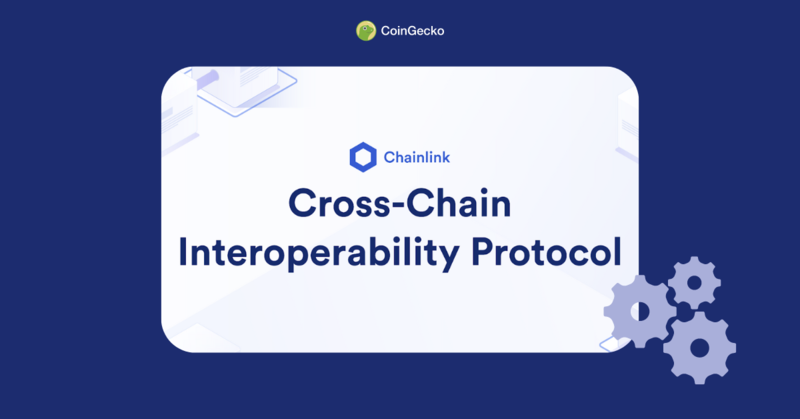What is Chainlink CCIP? Guide to the Cross-Chain Interoperability Protocol


One of the main highlights of Chainlink’s 2022 roadmap is the Chainlink Cross-Chain Interoperability Protocol (CCIP). With CCIP, Chainlink hopes to solve the interoperability problem plaguing smart contract blockchains.
The Blockchain Interoperability Problem
Smart contract platforms control a large portion of the total cryptocurrency market capitalization. In recent years, there has been a sharp growth in smart contract platforms, each with unique features and shortcomings. In what has become a phenomenon, one chain solves the problem of the other, but still has its own shortcomings.
A majority of new developments in this area are channeled towards creating a solution for these shortcomings and creating efficient communication between these platforms and the decentralized applications built on them.
Cross-chain technologies’ main purpose is to develop facilities that enable the exchange of information between different blockchains. Cross-chain bridges are arguably the most prominent cross-chain technology. Through cross-chain bridges, cryptocurrencies, NFTs and other data can be migrated from one blockchain to another.
Cross-chain bridges provide honest services – you can truly move tokens to another blockchain using bridging facilities. But it is far from solving the interoperability problem. Additionally, it comes with tons of security and user experience issues. A chain analysis report estimates that over $2 billion has been lost in chain mining in the first three quarters of 2022 alone. Bridging technologies are complicated and often open to exploitation.
Apart from the loss of safety, cross chain bridges are still underdeveloped and only useful for asset bridging. This is actually still miles away from establishing real ‘communication’ between blockchains. True interoperability between blockchains will enable one chain to use the facilities of the other. Don’t just exchange information recorded on their ledger.
Chainlink’s CCIP
Currently, Chainlink’s oracle protocol is used to provide price feeds on DeFi platforms across multiple smart contract blockchains. Hundreds of DeFi platforms on various blockchains with over $20 billion in cumulative value locked are secured by Chainlink’s Oracle network. Chainlink CCIP uses this secure consensus mechanism to create true communication between blockchains.
This communication goes beyond the exchange of assets, CCIP creates real communication between blockchains. Through CCIP, blockchains will be able to utilize each other’s facilities. This includes security infrastructure, scalability infrastructure, transaction processing facilities and many other features.
Developers building decentralized applications can leverage Chainlink CCIP to combine functions of different blockchains into a smart contract. The idea is to construct a smart contract which is essentially several contracts on several chains that interact with each other. With this, developers can build an application that enjoys the speed of one blockchain while using the security system of another blockchain and the scalability facilities of other chains.
Applications powered by CCIP will “unify” blockchains and enable seamless interactivity between them, using a single piece of smart contract code. Developers will be able to use multiple blockchains for the (individual) features they like. For example, a single application would be able to leverage the Ethereum blockchain’s security and decentralization, the Polygon blockchain’s speed and scalability, and use multiple decentralized oracle networks to provide data services.
New capabilities enabled by Chainlink’s CCIP
If one could easily combine the functions of two different systems, the super hybrids created would inevitably usher in many possibilities. Applying this to modern smart contract blockchain, every enthusiast can easily imagine a super hybrid of their choice and what these hybrids can bring to life. Here’s what you can create with Chainlink CCIP:
Low cost transaction calculation
Compared to other smart contract blockchains, Polygon blockchain’s transaction fees rank among the most economical. While using a relatively more expensive chain, you would like to pay a cheaper fee to get your transactions done. Chainlink CCIP enables one blockchain to leverage another blockchain’s facilities to process its transactions while bridging the data back for settlement.
This way, your transaction can be processed on a cheaper blockchain and confirmed on the parent blockchain. Simply put, you can pay Polygon blockchain fees for transactions initiated on a blockchain with relatively high costs.
Loan protocols across chains
Chainlink CCIP will allow users on one blockchain to borrow assets locked on another blockchain. Decentralized loan facilities in different chains can vary in liquidity, interest and fees paid to use the facility.
With CCIP, users of a relatively higher throughput chain can take advantage of the high liquidity and low interest rate of a lower throughput chain while enjoying the full efficiency of their own chain.
Crop farming across chains
DeFi farms across different chains can offer varying ROI percentages for the same liquidity pair or single side stake. Chainlink’s CCIP will enable crop farmers to cultivate interests on different chains. It optimizes harvesting by allowing farming and aggregation across multiple blockchain networks that provide the highest return on assets. Users’ assets can be easily moved around across chains to the farms that provide the best returns.
Related: What is yield farming and how to farm in 4 steps
New DeFi applications
With the possibilities that CCIP offers, new and sophisticated DeFi applications will emerge by combining the capabilities of different chains and complementing them with the extra features of ICCP. Super hybrid application with extensive functions. These applications will be “the best of both worlds” and differ significantly from today’s applications, especially in efficiency.
How Chainlink’s CCIP works
CCIP’s interactivity procedure comprises two communication blockchains: a message router at both ends (source and destination chains), and Chainlink’s Decentralized Oracle Network (DON).
DON is an advanced communication protocol, it supports the creation of hybrid smart contracts. Hybrid smart contracts create secure communication between on-chain and off-chain systems using one smart contract code. Chainlink’s DON is currently popular for supporting Hybrid Smart Contracts and then creating communication between the blockchain and the outside world. With CCIP, Chainlink’s DON will evolve to create communication between different blockchains.
The Cross-Chain Interoperability Protocol mediates between blockchains. It creates a path for blockchains to send and receive messages between each other. Messages sent through this route vary widely. They may include initiated smart contract transactions, account data or crypto asset transfers.

When a message is sent, it invokes the Messaging Router end of the source blockchain. The message router from the source chain uses Chainlink’s DON to forward messages to the destination chain. The message sent to the destination chain through Chainlink’s DON is validated by the Messaging router on the destination chain, translated into the chain’s language (where necessary), and sent to the destination chain’s smart contract. Records of the executed transaction are confirmed by the source chain.
According to Chainlink’s founder, Sergey Nazarov, applications built using CCIP will be compatible with web2 systems, existing interfaces and wallets. This means developers don’t have to worry about building new systems to support their CCIP-powered decentralized applications.
One of the applications powered by CCIP is the programmable token bridge. With the programmable token bridge, users and smart contracts can send tokens and commands to other blockchains. For users, it is not necessary to have a good knowledge of how the other blockchain works. Bridged smart contract commands will run perfectly on the destination chain without being modified by the developer.
CCIP will be secured by Chainlink’s Anti-fraud network. The Anti-Fraud Network is a committee of autonomous nodes that control transactions on the CCIP to detect malicious transactions. The network adds an extra layer of security to CCIP. It acts as a transaction verification layer and performs regular checks on the CCIP facility. 
The anti-fraud network reserves the power to stop malicious transactions. Depending on the severity of the attack, the anti-fraud network may trigger the shutdown of the relevant cross-chain service to protect users.
Current development of Chainlink’s CCIP
CCIP’s release was announced on August 5, 2021. Since then, efforts have been made to optimize the technology in anticipation of the final release. On January 27, 2022, Chainlink announced that Christian Catalini (chief economist and co-creator of the now-defunct Diem) and Dan Boneh, (a cryptographer at Stanford University) were added to the team. The new members will assume advisory roles for the standardization of CCIP.
As reported, crypto lending platform Celsius will be the first DeFi platform to implement CCIP in its services. When finally released, CCIP will permeate the core DeFi and smart contract platforms.
Final thoughts
In a rapidly expanding world of smart contract blockchains and cross-chain solutions, Chainlink’s CCIP plays an important role, a role that could prove to be an incredible solution to the blockchain interoperability problem. A solution to the increasing diversity in new smart contract blockchains. When properly implemented, CCIP solves several problems for blockchain enthusiasts.
Rather than “managing” the shortcomings of a system because of its benefits, a blockchain application can complement one blockchain or cross-chain solution by using the other.
For developers, it speeds user adoption and simplifies the creation of super-efficient applications, providing the best possible user experience in existence. A really interesting thing is that CCIP offers all of these on a platter. Implementing Chainlink CCIP in an application will require less effort than the capabilities they provide for DeFi applications.
As Nazarov said, CCIP will usher in a whole new category of more advanced hybrid smart contracts and pioneer a new breed of DeFi applications and Web3 developers. It does this by unifying blockchain and cross-chain solutions. A new level of interoperability in the Web3 space in two aspects – social and technological.
On the social side, it brings the blockchain community and developers together. Users on one blockchain can automatically apply the provisions of the other blockchain. The scenario this creates goes beyond simply using protocols from different blockchains or borrowing assets locked by a peer on another blockchain.
On the technological side, blockchains can not only communicate with each other, but also borrow facilities from each other.
With cross-chain bridges a breeding ground for hackers and exploitation, Chainlink CCIP will provide blockchain users with a new level of security. With CCIP, migrating tokens to another blockchain will require less effort than using third-party bridges and presents a more secure migration infrastructure.
To learn more about cryptocurrency and DeFi protocols, check out CoinGecko Learn.
Joel Agbo
Joel loves to discuss cryptocurrency and blockchain technology. He is the founder of CryptocurrencyScripts. Follow the author on Twitter @agboifesinachi

























